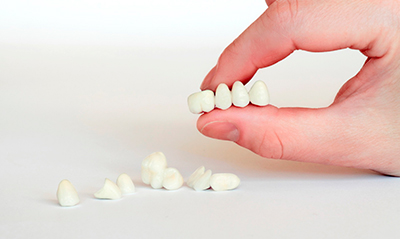One of the ways to restore the anatomical shape of teeth is through non-removable restoration with crowns or crownoplasty. A crown is an artificial tooth that is installed on the prepared crown part of a natural tooth or on an abutment (support) during implant prosthetics.
Ceramic restoration is fixed on a severely damaged tooth and serves two functions: withstanding natural chewing loads and providing an aesthetic appearance as close as possible to a natural tooth.
Did you know that the precursor of modern artificial teeth made of gold with porcelain overlay was created several centuries ago? At that time, the pioneer of modern dentistry, Pierre Fauchard, could not imagine that materials for prosthetics could include not only gold and donor teeth used at that time.
In EOK, crowns are made of:
- CAD/CAM milled from zirconium dioxide with ceramic overlay;
- pressed and with ceramic overlay using IPS Empress and E. max technology from a German manufacturer;
- metal-ceramic from a biological dental alloy with a full ceramic margin.
What are the differences between these orthopedic constructions?
Ten years ago, metal-ceramics firmly occupied a niche as the main material for making artificial dental prostheses due to their strength and sufficient level of aesthetics.
Gradually, one of the best options for dental prosthetics materials, popular among patients, has become non-metal constructions made of zirconium dioxide, Empress glass ceramics, and E. max. These materials have become perfect for prosthetics of both anterior and posterior teeth due to their super strength, high transparency, aesthetics, biocompatibility, and hypoallergenicity. Non-metal ceramics have the property of reproducing all shades on the Chromoscope color scale. The peculiarity of orthopedic constructions made of zirconium dioxide is that the gums are illuminated from the inside, creating a visual effect of natural tooth enamel.
Installation of Crowns
- Comprehensive Approach. Treatment involving clinic specialists: hygienists, surgeons, periodontists, orthodontists, therapists, orthopedists, and gnathologist.
- Highly Qualified Specialists. Prosthetics are performed by doctors of the highest category, continuously improving their professional level;
- Application of Innovative Technologies IPS Empress and E. max pressing, as well as CAD/CAM technologies;
- Observation. Preventive check-ups after orthopedic treatment are a rule in our clinic.

